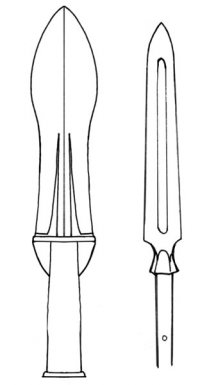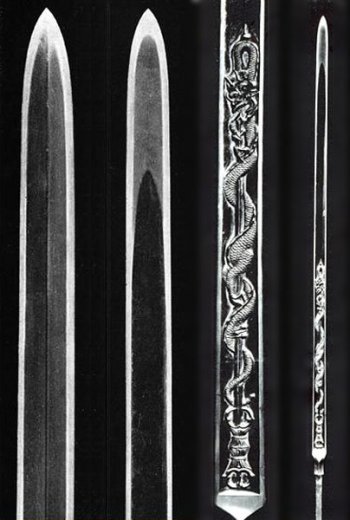Written by Kagita Chūbee, 20th sōke (headmaster) of the Hōzōinryū
Yari and Hoko
This time I would like to write about the types of spears called yari and hoko.
 Where is the difference between a yari and a hoko? In general one could say that the blades of hoko usually have sweeping cutting edges and an obtuse point whereas a yari has straight cutting edges and an acute point. But there is no unambiguous definition.
Where is the difference between a yari and a hoko? In general one could say that the blades of hoko usually have sweeping cutting edges and an obtuse point whereas a yari has straight cutting edges and an acute point. But there is no unambiguous definition.
Already Arai Hakuseki (1657 - 1725), a scholar from the Edo period1 did research on the topic of yari and hoko. In his work "Tōga"2 we find the following passage:
"When Tenji Tennō3 was still called (prince) Naka-no-ōe he took to a long spear to slay the minister (Soga-no-) Iruka."
But, as the author noted, it is not clear whether a yari or a hoko was used. In my opinion the best explanation would be that the same weapon was called hoko in ancient times and yari since the Nanbokuchō period4.
Assumedly sharpend poles made from wood or bamboo had been used for hunting and fighting since primeval times. In the Stone Age those weapons were enhenced with tips made from horn or stone.
Like the Kojiki5 depicts the two deities Izanagi and Izanami thrusting down with the jeweled spear "Ame-no-nuboko" from the bridge floting in the heavens the use of hoko can be watched from the Kofun period6 into the Nara period7. After that their use, for what reasons ever, fell into decline until naginata became the predominant polearm at the end of the Heian period8 and during the Kamakura period9. In modern budō the naginata is mainly used by women but in those days it was a weapon wielded by men, just as in the legendary duel between Musashibō Benkei and Ushiwakamaru10 on the Gojō bridge in Kyōto.
Perhaps the long spears used by the army of the Mongols who tried to invade Japan11 at the end of the Kamakura period left an impression of being of advantage for after that the use of spears slowly spread all over Japan.
The first time the term yari appeared in writing was in the year Genkō 4 (1334) in the "Sogashi-monjo"12. There is written:
"On the eights day of the new year Yagi Yajiro was stuck in the chest with a spear which left him more dead than alive."
Which makes this Yagi Yajiro the first literary spear victim in Japan.
In the Nanbokuchō period the 1000 spears of Kikuchi became famous because thanks to bamboo poles to which daggers were mounted Kikuchi Takeshige routed Ashikaga Takauji's army of 3000 soldiers with only 1000 warriors in the battle of Take-no-shita13 at Hakone.
In the battles of the Sengoku period14, after bullets and arrows were shot, strategies of group fighting were employed. For example yaribusuma (spear screen) a formation in which soldiers with very long spears would fight shoulder to shoulder. A spear is not only good for thrusting but also for striking which made it a weapon of immense destructive force even in the hands of badly trained low ranking soldiers.
The yari continued to be the star on the battlefield as is testified by the role the "seven spears" played in the battle of Shizugatake15 where Hashiba Hideyoshi16 defeated Shibata Katsuie.
The sōjutsu of our Hōzōinryū by the way was also developed at the end of the Sengoku period.
Then, after the Edo period began and peace once more prevailed spears decorated the front lines in daimyō processions or were used as ceremonial weapons to guard castle gates or border posts.
 The famous spear Nihongō which is sung about in the folk song Kurodabushi17 (blade length 97,2 cm).
The famous spear Nihongō which is sung about in the folk song Kurodabushi17 (blade length 97,2 cm).
(First published in the Nara town magazine Ubusuna on February 5th 2009)
1. 1603 - 1868
2. Approximately: The Style of the East.
3. 626 - 672; the Killing of Soga which broke the power of his clan took place in 645 and is known as the Isshi incident.
4. 1336 - 1392
5. Record of Ancient Matters, 712.
6. Second half of the third century until 538; during the following Asuka period until 710 burial mounds were still errected though.
7. 710 - 794
8. 794 - 1185
9. 1185 - 1333
10. The youth name of Minamoto-no-Yoshitsune.
11. 1274 and 1281
12. Records on the Soga clan.
13. December 11th 1335
14. 1467 - 1568
15. May/June 1583
16. Better known as Toyotomi Hideyoshi.
17. A folk song from Fukuoka.